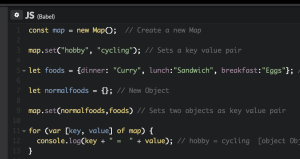class must be declared before anything can be achieved. In JavaScript, it’s easy to create objects on the fly. For example:
// ES5-compatible code
var myObject = {
prop1: 'hello',
prop2: 'world',
output: function() {
console.log(this.prop1 + ' ' + this.prop2);
}
};
myObject.output(); // hello world
Object Initialization From Variables
Objects’ properties are often created from variables with the same name. For example:// ES5 code
var
a = 1, b = 2, c = 3;
obj = {
a: a,
b: b,
c: c
};
// obj.a = 1, obj.b = 2, obj.c = 3
// ES6 code
const
a = 1, b = 2, c = 3;
obj = {
a
b
c
};
// obj.a = 1, obj.b = 2, obj.c = 3
// ES6 code
const lib = (() => {
function sum(a, b) { return a + b; }
function mult(a, b) { return a * b; }
return {
sum,
mult
};
}());
console.log( lib.sum(2, 3) ); // 5
console.log( lib.mult(2, 3) ); // 6
// lib.js
function sum(a, b) { return a + b; }
function mult(a, b) { return a * b; }
export { sum, mult };
Object Method Definition Shorthand
Object methods in ES5 require thefunction statement. For example:
// ES5 code
var lib = {
sum: function(a, b) { return a + b; },
mult: function(a, b) { return a * b; }
};
console.log( lib.sum(2, 3) ); // 5
console.log( lib.mult(2, 3) ); // 6
// ES6 code
const lib = {
sum(a, b) { return a + b; },
mult(a, b) { return a * b; }
};
console.log( lib.sum(2, 3) ); // 5
console.log( lib.mult(2, 3) ); // 6
=> function syntax here, because the method requires a name. That said, you can use arrow functions if you name each method directly (like ES5). For example:
// ES6 code
const lib = {
sum: (a, b) => a + b,
mult: (a, b) => a * b
};
console.log( lib.sum(2, 3) ); // 5
console.log( lib.mult(2, 3) ); // 6
Dynamic Property Keys
In ES5, it wasn’t possible to use a variable for a key name, although it could be added after the object had been created. For example:// ES5 code
var
key1 = 'one',
obj = {
two: 2,
three: 3
};
obj[key1] = 1;
// obj.one = 1, obj.two = 2, obj.three = 3
[ square brackets ]. For example:
// ES6 code
const
key1 = 'one',
obj = {
[key1]: 1,
two: 2,
three: 3
};
// obj.one = 1, obj.two = 2, obj.three = 3
// ES6 code
const
i = 1,
obj = {
['i' + i]: i
};
console.log(obj.i1); // 1
// ES6 code
const
i = 2,
obj = {
['mult' + i]: x => x * i
};
console.log( obj.mult2(5) ); // 10
Destructuring (Variables From Object Properties)
It’s often necessary to extract a property value from an object into another variable. This had to be explicitly declared in ES5. For example:// ES5 code
var myObject = {
one: 'a',
two: 'b',
three: 'c'
};
var
one = myObject.one, // 'a'
two = myObject.two, // 'b'
three = myObject.three; // 'c'
// ES6 code
const myObject = {
one: 'a',
two: 'b',
three: 'c'
};
const { one, two, three } = myObject;
// one = 'a', two = 'b', three = 'c'
{ propertyName: newVariable }. For example:
// ES6 code
const myObject = {
one: 'a',
two: 'b',
three: 'c'
};
const { one: first, two: second, three: third } = myObject;
// first = 'a', second = 'b', third = 'c'
// ES6 code
const meta = {
title: 'Enhanced Object Literals',
pageinfo: {
url: 'https://www.sitepoint.com/',
description: 'How to use object literals in ES2015 (ES6).',
keywords: 'javascript, object, literal'
}
};
const {
title : doc,
pageinfo: { keywords: topic }
} = meta;
/*
doc = 'Enhanced Object Literals'
topic = 'javascript, object, literal'
*/
- the left-hand side of the assignment is the destructuring source — the array or object which holds the data being extracted
- the right-hand side of the assignment is the destructuring target — the pattern which defines the variable being assigned.
{ a, b, c } = myObject; // FAILS
const { a, b, c } = myObject; // WORKS
let a, b, c;
({ a, b, c } = myObject); // WORKS
Default Function Parameters
It’s often easier to pass a single object to a function than use a long list of arguments. For example:prettyPrint( {
title: 'Enhanced Object Literals',
publisher: {
name: 'SitePoint',
url: 'https://www.sitepoint.com/'
}
} );
// ES5 assign defaults
function prettyPrint(param) {
param = param || {};
var
pubTitle = param.title || 'No title',
pubName = (param.publisher && param.publisher.name) || 'No publisher';
return pubTitle + ', ' + pubName;
}
// ES6 default value
function prettyPrint(param = {}) { ... }
// ES6 destructured default value
function prettyPrint(
{
title: pubTitle = 'No title',
publisher: { name: pubName = 'No publisher' }
} = {}
) {
return `${pubTitle}, ${pubName}`;
}
Parsing Returned Objects
Functions can only return one value, but that could be an object with hundreds of properties and/or methods. In ES5, it’s necessary to obtain the returned object, then extract values accordingly. For example:// ES5 code
var
obj = getObject(),
one = obj.one,
two = obj.two,
three = obj.three;
// ES6 code
const { one, two, three } = getObject();
fs) methods readFile and writeFile, you could reference them directly. For example:
// ES6 Node.js
const { readFile, writeFile } = require('fs');
readFile('file.txt', (err, data) => {
console.log(err || data);
});
writeFile('new.txt', 'new content', err => {
console.log(err || 'file written');
});
ES2018 (ES9) Rest/Spread Properties
In ES2015, rest parameter and spread operator three-dot (...) notation applied to arrays only. ES2018 enables similar rest/spread functionality for objects. A basic example:
const myObject = {
a: 1,
b: 2,
c: 3
};
const { a, ...x } = myObject;
// a = 1
// x = { b: 2, c: 3 }
restParam({
a: 1,
b: 2,
c: 3
});
function restParam({ a, ...x }) {
// a = 1
// x = { b: 2, c: 3 }
}
const
obj1 = { a: 1, b: 2, c: 3 },
obj2 = { ...obj1, z: 26 };
// obj2 is { a: 1, b: 2, c: 3, z: 26 }
obj2 = { ...obj1 };), but be aware you only get shallow copies. If a property holds another object, the clone will refer to the same object.
ES2018 (ES9) rest/spread property support is patchy, but it’s available in Chrome, Firefox and Node.js 8.6+.
Object literals have always been useful. The new features introduced from ES2015 did not fundamentally change how JavaScript works, but they save typing effort and lead to clearer, more concise code.
Frequently Asked Questions (FAQs) about ES6 Enhanced Object Literals
What are the key features of ES6 Enhanced Object Literals?
ES6 Enhanced Object Literals introduce several key features that simplify the process of working with objects in JavaScript. These include shorthand property names, which allow you to define properties without repeating the property name, and shorthand method names, which simplify the syntax for defining methods. ES6 also introduces computed property names, which allow you to dynamically create property names based on variable values.
How do shorthand property names work in ES6 Enhanced Object Literals?
Shorthand property names in ES6 Enhanced Object Literals allow you to define properties in a more concise way. Instead of writing {x: x, y: y}, you can simply write {x, y}. This feature is particularly useful when you are working with large objects, as it can significantly reduce the amount of code you need to write.
How do shorthand method names work in ES6 Enhanced Object Literals?
Shorthand method names in ES6 Enhanced Object Literals simplify the syntax for defining methods. Instead of writing {myMethod: function() {...}}, you can write {myMethod() {...}}. This makes your code cleaner and easier to read.
What are computed property names in ES6 Enhanced Object Literals?
Computed property names in ES6 Enhanced Object Literals allow you to dynamically create property names based on variable values. For example, you can write let propName = 'myProp'; let obj = {[propName]: 'value'}; to create a property named ‘myProp’ with the value ‘value’. This feature is useful when you need to create property names dynamically, for example, when working with user input.
How can I use ES6 Enhanced Object Literals in my code?
To use ES6 Enhanced Object Literals in your code, you simply need to use the new syntax when defining your objects. For example, instead of writing {x: x, y: y}, you can write {x, y}. Similarly, instead of writing {myMethod: function() {...}}, you can write {myMethod() {...}}. To use computed property names, you can write {[propName]: 'value'}.
What are the benefits of using ES6 Enhanced Object Literals?
ES6 Enhanced Object Literals offer several benefits. They make your code cleaner and easier to read, and they can significantly reduce the amount of code you need to write when working with large objects. They also allow you to dynamically create property names, which can be useful when working with user input.
Are there any drawbacks to using ES6 Enhanced Object Literals?
One potential drawback to using ES6 Enhanced Object Literals is that they are not supported in older browsers. However, this can be mitigated by using a transpiler like Babel to convert your ES6 code into ES5 code, which is supported in all browsers.
Can I use ES6 Enhanced Object Literals with other ES6 features?
Yes, you can use ES6 Enhanced Object Literals with other ES6 features. For example, you can use them with arrow functions, template literals, and destructuring assignment. This allows you to write even more concise and readable code.
How do ES6 Enhanced Object Literals compare to traditional object literals?
ES6 Enhanced Object Literals offer several improvements over traditional object literals. They allow you to define properties and methods in a more concise way, and they allow you to dynamically create property names. However, they are not supported in older browsers, so you may need to use a transpiler if you need to support these browsers.
Where can I learn more about ES6 Enhanced Object Literals?
There are many resources available online where you can learn more about ES6 Enhanced Object Literals. Some good places to start include the Mozilla Developer Network (MDN) and various JavaScript tutorials and blogs. You can also experiment with ES6 Enhanced Object Literals in online code editors like JSFiddle or CodePen.
Craig is a freelance UK web consultant who built his first page for IE2.0 in 1995. Since that time he's been advocating standards, accessibility, and best-practice HTML5 techniques. He's created enterprise specifications, websites and online applications for companies and organisations including the UK Parliament, the European Parliament, the Department of Energy & Climate Change, Microsoft, and more. He's written more than 1,000 articles for SitePoint and you can find him @craigbuckler.


